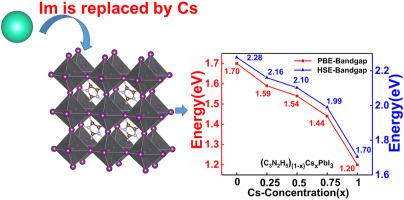Solar Energy Materials and Solar Cells ( IF 6.9 ) Pub Date : 2021-09-22 , DOI: 10.1016/j.solmat.2021.111401 Zhengyang Gao 1, 2, 3 , Min Wang 1, 2, 3 , Hanwen Zhang 1, 2, 3 , Shengyi Chen 1, 2, 3 , Chongchong Wu 4 , Ian D. Gates 4 , Weijie Yang 1, 2, 3 , Xunlei Ding 5, 6 , Jianxi Yao 7, 8

|
Due to its unique properties, such as long carrier diffusion length and adjustable optical band gap, organic-inorganic hybrid perovskite has been a potentially strong photoelectric material for solar cells. However, the challenge of insufficient stability of perovskite materials has not been solved, which in turn, limits its commercial application. Inspired by the strong stability of C3N2H5PbI3 (ImPbI3), we present an innovative doped system, Im(1-x)CsxPbI3 (x = 0.25, 0.5, 0.75), based on the cation-doped strategy, to obtain both strong stability and excellent photoelectric performance. A new perovskite phase ImPbI3 is proposed and verified rationality of existence through formation energy, ab initio molecular dynamics (AIMD), mean square displacement (MSD), and X-ray diffraction (XRD) based on density functional theory (DFT) calculations. For analyzing the photoelectric properties of Im(1-x)CsxPbI3, the bandgap, charge distribution of the frontier molecular orbital, and projected density of states are investigated. To study the stability of Im(1-x)CsxPbI3, geometric configuration, tolerance factor, crystal orbital Hamilton populations (COHP), and AIMD simulations are performed. The results show that the perovskite phase ImPbI3 has strong thermodynamic stability and structural stability, and its optical bandgap value is lower than that of the hexagonal system. When the content of doped Cs does not exceed 50%, the stability of the perovskite phase ImPbI3 is significantly improved. Comprehensive analysis shows that Im0.5Cs0.5PbI3 exhibits encouraging performance with strong stability and high optical absorption coefficient. This theoretical study opens a new avenue for the design of robust organic-inorganic hybrid perovskite materials with strong stability and excellent photoelectric performance based on our findings from perovskite phase ImPbI3 system.
中文翻译:

(C3N2H5)(1-x)CsxPbI3 作为一种新型杂化钙钛矿的设计,具有很强的稳定性和优异的光电性能:理论预测
由于其独特的性质,例如长载流子扩散长度和可调光学带隙,有机-无机杂化钙钛矿已成为太阳能电池的潜在强光电材料。然而,钙钛矿材料稳定性不足的挑战并没有得到解决,这反过来又限制了其商业应用。通过C的稳定性强的启发3 Ñ 2 ħ 5碘化铅3(ImPbI 3),我们提出了一种创新的掺杂系统,林(1- X) Cs的X碘化铅3(X = 0.25, 0.5, 0.75),基于阳离子掺杂策略,获得强稳定性和优异的光电性能。提出了一种新的钙钛矿相ImPbI 3并通过形成能、从头分子动力学(AIMD)、均方位移(MSD)和基于密度泛函理论(DFT)计算的X射线衍射(XRD)验证了存在的合理性。为了分析 Im (1- x ) Cs x PbI 3的光电特性,研究了带隙、前沿分子轨道的电荷分布和投影态密度。研究 Im (1- x ) Cs x PbI的稳定性参照图3,进行几何构型、公差因子、晶体轨道哈密顿布居(COHP)和AIMD模拟。结果表明,钙钛矿相ImPbI 3具有较强的热力学稳定性和结构稳定性,其光学带隙值低于六方晶系。当掺杂Cs的含量不超过50%时,钙钛矿相ImPbI 3的稳定性显着提高。综合分析表明,Im 0.5 Cs 0.5 PbI 3表现出令人鼓舞的性能,具有很强的稳定性和高光吸收系数。基于我们在钙钛矿相ImPbI 3系统中的发现,该理论研究为设计具有强稳定性和优异光电性能的稳健有机-无机杂化钙钛矿材料开辟了新途径。



























 京公网安备 11010802027423号
京公网安备 11010802027423号